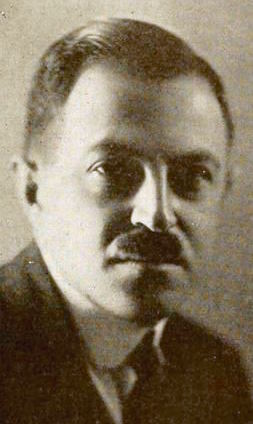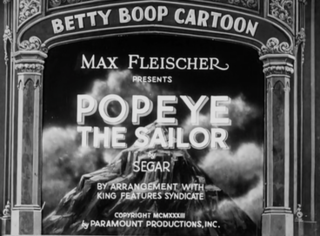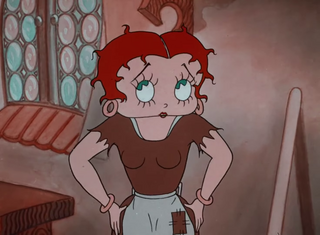Related Research Articles

Snow-White is a 1933 American animated short in the Betty Boop series from Max Fleischer's Fleischer Studios. Dave Fleischer was credited as director, although virtually all the animation was done by Roland Crandall, who received the opportunity to make Snow-White on his own as a reward for his several years of devotion to the Fleischer studio. The resulting film, which took six months to complete, is considered both Crandall's masterwork and an important milestone of the Golden age of American animation.

Olive Oyl is a cartoon character created by E. C. Segar in 1919 for his comic strip Thimble Theatre. The strip was later renamed Popeye after the sailor character that became the most popular member of the cast; however, Olive Oyl was a main character for a decade before Popeye's 1929 appearance.

Fleischer Studios was an American animation studio founded in 1929 by brothers Max and Dave Fleischer, who ran the pioneering company from its inception until its acquisition by Paramount Pictures, the parent company and the distributor of its films. In its prime, Fleischer Studios was a premier producer of animated cartoons for theaters, with Walt Disney Productions being its chief competitor in the 1930s.

Max Fleischer was a Polish-American animator, inventor, film director and producer, and studio founder and owner. Born in Kraków, Poland, Fleischer immigrated to the United States where he became a pioneer in the development of the animated cartoon and served as the head of Fleischer Studios, which he co-founded with his younger brother Dave. He brought such comic characters as Koko the Clown, Betty Boop, Popeye, and Superman to the movie screen, and was responsible for several technological innovations, including the rotoscope, the "follow the bouncing ball" technique pioneered in the Ko-Ko Song Car-Tunes films, and the "stereoptical process". Film director Richard Fleischer was his son.

Betty Boop is an animated cartoon character designed by Grim Natwick at the request of Max Fleischer. She originally appeared in the Talkartoon and Betty Boop film series, which were produced by Fleischer Studios and released by Paramount Pictures. She was featured in 90 theatrical cartoons between 1930 and 1939. She has also been featured in comic strips and mass merchandising.

Mae Questel was an American actress. She was best known for providing the voices for the animated characters Betty Boop, Olive Oyl and numerous others.

Myron "Grim" Natwick was an American artist, animator, and film director. Natwick is best known for drawing the Fleischer Studios' most popular character, Betty Boop.

Popeye the Sailor is a 1933 animated short produced by Fleischer Studios and distributed by Paramount Publix Corporation. While billed as a Betty Boop cartoon, it was produced as a vehicle for Popeye in his debut animated appearance.
Betty in Blunderland is a Fleischer Studios animated short film starring Betty Boop, which was released on the 6th of April in 1934. Also known as Betty in Flunkerland.
Betty Boop's Rise to Fame is a 1934 Fleischer Studios animated short film, starring Betty Boop.
Betty Boop, M.D. is a 1932 Fleischer Studios animated short film starring Betty Boop, and featuring Koko the Clown and Bimbo. The animated short is certainly one of the more surreal entries in the Betty Boop filmography.
Betty Boop's Ker-Choo is a 1932 Fleischer Studios animated short film starring Betty Boop, and featuring Koko the Clown and Bimbo.

Poor Cinderella is a 1934 Fleischer Studios-animated short film featuring Betty Boop. Poor Cinderella was Fleischer Studios' first color film, and the only appearance of Betty Boop in color during the Fleischer era. It was the first Paramount Pictures animated short in color.
Betty Boop and Grampy is a 1935 Fleischer Studios animated short film starring Betty Boop. The short features Grampy in his first appearance.
Betty Boop and Little Jimmy is a 1936 Fleischer Studio animated short film, starring Betty Boop and featuring newspaper comic strip character Little Jimmy.
Olive Oyl for President is a 1948 entry in the Popeye the Sailor animated short subject series, produced by Famous Studios and released on January 30, 1948 by Paramount Pictures. The short is a reworking of a 1932 Betty Boop cartoon, Betty Boop for President, and depicts what Popeye imagines the world would be like if Olive Oyl were president.

Popeye the Sailor is an American animated series of short films based on the Popeye comic strip character created by E. C. Segar. In 1933, Max and Dave Fleischer's Fleischer Studios, based in New York City, adapted Segar's characters into a series of theatrical cartoon shorts for Paramount Pictures. The plotlines in the animated cartoons tended to be simpler than those presented in the comic strips, and the characters slightly different. A villain, usually Bluto, makes a move on Popeye's "sweetie", Olive Oyl. The villain clobbers Popeye until he eats spinach, giving him superhuman strength. Thus empowered, Popeye makes short work of the villain.
Bonnie Poe was an American actress, best known for providing the voice for the Fleischer Studios animated character Betty Boop beginning in 1933, starting with the Popeye the Sailor series and featuring in a dozen cartoons. She voiced her in a live-action segment on the special Hollywood on Parade No. A-8, performing a skit with Bela Lugosi providing a portrayal of Count Dracula.

Minnie the Moocher is a 1932 Betty Boop cartoon produced by Fleischer Studios and released by Paramount Pictures.
Events in 1938 in animation.
References
- ↑ Lenburg, Jeff (1999). The Encyclopedia of Animated Cartoons. Checkmark Books. pp. 54–56. ISBN 0-8160-3831-7 . Retrieved June 6, 2020.
- 1 2 Saavedra, Scott (August 2020). "Cartoon Characters for President". RetroFan (10). United States: TwoMorrows Publishing: 13.